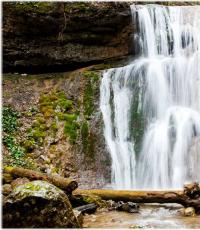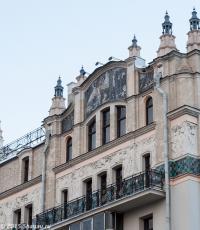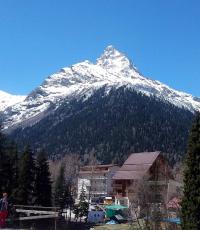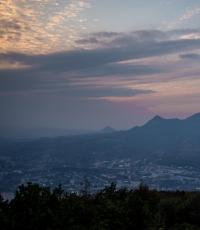Potala palace - ancient architecture. Potala Palace in Tibet: the highest ancient castle in the world Climbing the Potala. Interesting places
Lhasa - "the dwelling place of the gods", it was chosen by the Tibetan kings as the capital of the state. Until now, the researchers of Central Asia cannot unravel all the secrets of the city to the end. The mysteries of Lhasa also include a centuries-old building - the Potala Palace. With its beauty and grandeur, it has amazed people for hundreds of years. Every year thousands of tourists visit this place of Buddhist pilgrimage.
City of Lhasa. Potala Palace - the main attraction
The Chinese city of Lhasa is located in the valley of the beautiful Jichu River, which flows through. Above sea level, Lhasa is located at an altitude of 3680 meters. For many years it was the residence of the Dalai Lama. Only in 1979 the city became available for visiting tourists, until that time the entrance to foreigners was closed here. Barkhor Street runs in a circle through the center. According to the legends, there was a lake in the center of this ring, and in order for the townspeople to live in peace, the lake was filled up, and the Jokhang monastery was built on this site. In the Old City of Lhasa there are many valuable historical monuments: Sera, Drepung, Ganden monasteries, but the Tibetan Potala Palace can be called the most significant. For many years it has been surprising visitors with its unusualness, rare architecture, and magnificent style. Thousands of travelers come to Tibet to admire the beauty and uniqueness of the palace. Potala - - is located on the Red Hill, which is surrounded by the Lhaska valley.
Potala Palace, Tibet: the history of the building
According to legend, the Potala Palace was originally built in the 7th century by King Srontszangambo. The building was built for Princess Wencheng, his future wife. The building stretched from the foot to the top of the mountain, it united thousands of buildings made in the Tibetan style. During the hostilities of those years, the Tufan dynasty fell, and many halls of the palace were simply destroyed. Over time, natural disasters also had a bad effect on the condition of the walls of the building. Reconstruction began only in 1645. At that time, the Qing government determined the ruler of Tibet - the Fifth Dalai Lama. The palace became his residence.

The Potala Palace consisted of two parts - White and Red. The White Palace was built in 1653, and in 1694 the construction of the Red Palace was completed. The total height of the structure made of earth, stone, wood was 117 meters. The width of the palace is 335 meters. Thirteen floors occupy more than 130 thousand square meters, now the entire area occupies 360 thousand square meters. The palace includes more than 1100 rooms and halls, 200 thousand of various sculptures, more than 10 thousand chapels.
Description of the Potala Palace
Let's take a closer look at what the Potala Palace looks like. As mentioned above, it consists of spirit parts - White and Red. The White Palace houses the chambers of the Dalai Lama, the Red Palace serves as a venue for services. Utility rooms and monks' cells were built in the courtyard. It is best to start your tour of the Red Palace from the upper rooms, in particular from the Maitreya Chapel. The entrances to the chapels are located on the lowest tier. The western part is occupied by the tombs of the Dalai Lamas, as well as government offices. In the Solar Pavilion he lived, worked, wrote the sacred texts of the Dalai Lama, and was engaged in management. The large pavilion was used for official ceremonies. The Pabalakan Hall and the Fa-Vana Cave, which is considered a special part, are still left from the constructions of the 7th century.

Climbing the Potala. Interesting places
A sacred place among Buddhists is the Potala Palace, Tibet annually receives thousands of pilgrims. The ascent to the palace begins at the foot of the mountain from a blank wall. A winding stone path will lead to the eastern gate, on which four alohanis are depicted. The pavilion can be accessed through the palace wall, its height is four meters.
In the middle of the path, a huge terrace appears, its area is 1600 square meters. From here, the Dalai Lama spoke to the faithful assembled here. Further along the corridor you can climb to the largest pavilion - Pozhanggabo Tsoqinxia. It was here that religious solemn ceremonies were held in 1653, when the Shunzhi Emperor granted the Fifth Dalai Lama a golden seal and a letter. It was then that he was raised to the rank of saint.

Wherever the Potala Palace is depicted, the part where there are eight tombs, the so-called pagoda-stupas, is visible. The most luxurious and largest is the pagoda of the Fifth Dalai Lama. It is covered with sheet gold, 3721 kg of it was used up. The tomb is encrusted with rare precious stones.
The largest and oldest part of the palace
The largest pavilion of Pozhangmabo keeps inscriptions by the Qing Emperor Qianlong and amazing curtains donated by the Kangxi Emperor. The legend says that in order to weave these curtains, a special workshop was built, it took a whole year to make them. The oldest part of the palace is the Snoyagal pavilion. It is here that the sculptures of the great king Srontszangambo, all the dignitaries and Princess Wencheng have been kept for many years. Sasronlanjie is the highest pavilion; sacrifices were made here for memorial tablets and the image of Emperor Qianlong.
Beauty of the Potala Palace

The Potala Palace appears before the eyes of travelers as a majestic building of indescribable beauty. Golden roofs, granite walls, graceful cornices with gilded decorations give the building a fabulous, fantastic image. On the colored wall paintings - drawings of Buddhas and alokhans, a true reproduction of the life and work of the Fifth Dalai Lama. It also reflects the solemn entry of Princess Wencheng into Tibet. The murals reflect the entire development of Buddhism, ancient Tibetan culture. The oldest architectural ensemble - the Potala Palace - is an indestructible symbol of Tibet, the fruit of the mind and talent of the Chinese people. It testifies to the cultural unity between the Han and Tibetans.
In Buddhist mythology, the paradise where the bodhisattvas Avalokiteshvara and Tara live (corresponds to the Chinese paradise of Puto) ... Big Encyclopedic Dictionary
- (Skt. potala, potalaka, pautalaka), in Buddhist mythology, the name of the paradise where Avalokiteshvara and Tara live. According to Indian and Tibetan sources, it is located on the top of a mountain on the coast of the Indian Ocean, in Chinese Buddhism on an island in ... ... Encyclopedia of mythology
POTALA, in Buddhist mythology, a paradise where bodhisattvas (see. BODHISATTVA) Avalokiteshvara (see. AVALOKITESHVARA) and Tara (see. TARA (in mythology)) live (corresponds to the Chinese paradise of Puto) ... encyclopedic Dictionary
- (Skt.) 1) in buddh. mythology is the name of the paradise where the bodhisattva Avalokiteshvara and his female energy Tara live; 2) the palace and winter residence of the Dalai Lama in Lhasa (until 1959), one of Ch. shrines of Tibet; named after the paradise of the bodhisattva Avalokiteshvara ... Buddhism
Potala- in buddh. myth. name paradise where Avalokiteshvara and Tara dwell. According to ind. and Tibetan sources, located on the top of a mountain on the coast of the Indian Ocean ... Ancient world. encyclopedic Dictionary
sweated- and, well. Z їdannya, iznischennya. || Likholittya, famously, bіda. Look forward to the sweat… Ukrainian glossy dictionary
sweated- the name of the female family ... Spelling Dictionary of Ukrainian Movies
Coordinates: 29°39′35″ s. sh. 91°07′01″ E / 29.659722° N sh. 91.116944° E etc. ... Wikipedia
A city in the southwest of China, c. Tibetan aut. r on. It is the main religious center of Lamaism (one of the forms of Buddhism) in Asia, which is reflected in the name: Tibet. lha god, sa land, i.e. divine, sacred land. Geographical names ... ... Geographic Encyclopedia
City Lhasa 拉薩, 拉萨, Lāsà Country ChinaChina Status ... Wikipedia
Books
- The most famous places in the world, C. Allende, F. Amalfi, T. Gomez. The romantic Taj Mahal, the mysterious Stonehenge, the ancient pyramids of Giza, the sacred Mount Kailash, the lost cities of the Incas and the Maya, the holy city of Jerusalem, the pearl of the East Samarkand,…
- Rampa's Story, T. Lobsang Rampa. "My brother, we must bring to the knowledge of many the truth that one person can voluntarily leave his body and allow another person to occupy and revive the abandoned body. Your task ...
Tibet is home to one of the most beautiful Buddhist palaces in the world, the Potala. The building got its name in the 11th century. In 1994, the Potala Temple was included in the UNESCO World Heritage List. It is located at an altitude of more than 3 thousand meters. The Potala Temple is the official winter representation of the Dalai Lama. It was here that all the ceremonies, meetings with the Tibetan government were held. Currently, a lot of tourists from around the world come here to see with their own eyes all the beauty and power of the Tibetan temple, to get acquainted with rare exhibits.
History of the Potala
This beautiful temple complex is located in the picturesque Lhasa Valley on Mount Marpo Ri. In Tibet, it is one of the tallest monumental structures. According to a mythical legend, Songtsen Gempo (a Tibetan ruler in the 7th century AD) meditated in a cave on Mount Marpo Ri. Later, he decided to build a temple complex on the hill. The building had its original appearance until the 17th century. With the help of the Dalai Lama in 1648, the temple was restored and slightly reconstructed. Today it is this building that travelers can see when they arrive in Tibet. About 7 thousand workers and 1,000 artists took part in the construction of the structure.

In 1922, the Supreme Head of Tibet repaired the halls and other places of worship in the White Palace, and the workers also restored the Red Palace. This great building was damaged only once - in 1959 during the invasion of the Chinese.
In addition, the temple remained in excellent condition even after the robberies of the Red Guards, who destroyed many Tibetan palaces in the 60-70s. 20th century. In the Potala temple complex, all the exhibits and sanctuaries at that time remained intact.
Once upon a time, administrators and religious mentors were trained in the castle. In the White Palace are small chapels that are valued for their safety and sacredness.

White Palace
The Potala Temple consists of the White and Red Palaces. In the White Palace you can see the rooms of the monks of the Supreme Head of Tibet, the Solar and the Great East Pavilions.
It is worth noting that the Solar Pavilion consists of an eastern and a western part. The rooms of the thirteenth Supreme Head of Tibet are located in the western part, and the rooms of the fourteenth Dalai Lama are located in the eastern part. Tourists will be able to see brocade blankets, jasper and gold tea utensils, porcelain sculptures, statues of Shakyamuni Buddha and much more in the Sun Pavilion.
The Great East Pavilion is the largest in the White Palace. It was here that cultural celebrations and political meetings took place. The walls of the Great Eastern Pavilion are decorated with frescoes on the themes: “the life story of a princess”, “how a monkey turned into a man”. In the center of the large pavilion stands a large statue of the Dalai Lama.

Red Palace
In the Red Palace, the monks of the Dalai Lama read prayers in the name of Buddha Shakyamuni. Here you can see many pavilions with memorial shrines and other unusual rooms.
The Red Palace has eight sanctuaries, among which it is worth highlighting the rooms of the thirteenth Dalai Lama and the fifth Supreme Head of Tibet. Them appearance just surprises. They are so large and luxurious that any tourist will definitely remember the memorial sanctuaries in the Potala for a lifetime. The stupa of the fifth Dalai Lama has a height of more than fourteen meters (five-story building). It is completely made of real gold. Tibetan memorial shrines alone are a large part of the world's wealth.
The Stupa of the thirteenth Dalai Lama rises to a height of about 14 m. It was built in 1934.

In the Red Palace, travelers will see various attributes, unique scriptures, unusual items and handicrafts, icons of Buddhist saints, frescoes depicting the construction of the Tibetan temple complex.
The highest and most spacious hall of the Red Palace is its western part. This is where the Dalai Lama once received guests, held ceremonial events and held sacrifices. Among the exhibits there is a banner with imperial painting, brocade and gold threads. You can also see the statue of the many-armed and many-faced Avalokiteshvara, made of silver and gold.
The most ancient attraction of the temple complex is the Pabalakan pavilion (Avalokiteshvar) and the Favana cave (27 sq. km.). The pavilion is located directly above the cave, which allows tourists to view the beauty of the complex. Fawan Cave houses rare statues of princesses of the Tufan Kingdom: Ludongzang, Chizul and Wencheng.

Most of the roofs of the pavilions of the palace are covered with gilding and have a traditional Chinese shape with flying corners, which are often decorated with animals from legends.
Potala Palace is a monument of Buddhist architecture. Many exhibits here are unique and amazing. Having visited this Palace, travelers want to come back here again.
The structure, 320 m long and 110 m high, around which eagles soar, is divided into the White and Red Palaces. The White Palace of the Potala with a defensive socle in its present form arose under the 5th Dalai Lama starting in 1645 with the participation of a large number of serfs. From more ancient fortress, which existed on this mountain since the time of Songtsen Gampo (VII century), there is practically nothing left - although the legend says that the meditation cave (see below) and the Phagpa hall are relics of that time. The White Palace contains rooms that perform purely practical functions, including sleeping quarters, study rooms and an audience hall for the Dalai Lama. In addition, the monastic tract, administrative premises and warehouses are located here. The most important shrines are located in the Red Palace, built under the regent of the 6th Dalai Lama until 1694. Since then, the appearance of the Potala has not changed much.
Inspection
The main entrance to the Potala Palace, through which the pilgrims go, leads up the other side of the fortress mountain (the so-called Red Mountain), which faces the Old City, to the eastern part of the White Palace. Tourists, as part of a booked program, are driven along the road from the west to the north side of the Red Palace, so that they enter the holy of holies, so to speak, through the back door. From there it is necessary to proceed along the route of inspection leading to all the important rooms with an unusually large number of magnificent works of art.
Great West Hall
The center of the Red Palace is the Great Western Hall, the enthronement hall. Its walls are decorated with murals depicting episodes from the life of the Dalai Lamas, Tibetan kings and the incarnations of the bodhisattva Avalokiteshvara. The four rooms surrounding the western hall can, based on their religious meaning, be considered the history of Tibetan Buddhism: the Padmasambhava hall tells about its origins; it is dedicated to that Indian saint who arrived in Tibet in the 8th century, subjugated the demons of the local religion and instructed them to stand guard over Buddhism from now on. The next room is the hall of the reformer Tsongkhapa, whose heir later became the 1st Dalai Lama. The third room is dedicated to him and his four subsequent incarnations. The fourth is fraught with tomb stupas with the bodies of the 5th, 10th and 12th Dalai Lamas. We are talking about 14-meter, richly gilded and jeweled pagodas with relics. The central stupa of the 5th Dalai Lama is the most luxurious decoration of the Potala. In similar caskets in the Red Palace, the mortal shells of eight Tibetan priest-kings are buried. Outside, their exact location is indicated by the gilded roofs of the Red Palace.
Top floor
Stairs in the northeast of the western hall lead through an intermediate floor with wall paintings, which, among other things, depict the construction of the Potala, to the upper floor with other significant halls and wonderful images. Here in the northeast corner is also the meditation hall of King Songtsen Gampo. This room with models of rocks, designed as a grotto, dates back to the founding of Lhasa and the origins of the Potala Palace, as well as Tibetan Buddhism in general. Plastically, the king is depicted between the thirty-eight-armed Avalokiteshvara and the 5th Dalai Lama; further on are the statues of the wives of Songtsen Gampo, Padmasambhava and others.
Phagpa Hall
The circular corridor leads further to the hall of the peaceful and wrathful gods, as well as to two halls full of many valuable metal sacrificial gifts. Above them is the Phagpa Hall. At the left entrance to it are footprints and hands allegedly left by Padmasambhava, Tsongkhapa and the 12th Dalai Lama. The main statues in the room are three statues of Avalokitesvara made of sandalwood, which supposedly came out as natural formations from a split tree trunk; therefore, believers see in these figures a manifestation of the otherworldly, and, accordingly, great reverence is shown to them.
Stupa of the 13th Dalai Lama and private quarters
If you go to the left, you can reach the tomb stupa of the 13th Dalai Lama, who died in 1933. Next is the private quarters of the 6th Dalai Lama, a life-loving man who did not obey monastic vows and was subsequently allegedly killed. Amitayus, the Buddha of Longevity, is worshiped in this room today. The staircase leads to the attic floor with the Maitreya Hall, which houses the throne of the 8th Dalai Lama. The rooftop platform offers a beautiful view of the city. Further, a circular corridor leads to the private chambers of the 13th and 14th (current) Dalai Lamas. Since the latter fled from Tibet in 1959, the premises allotted to him have practically retained their original appearance. Through the courtyard and extremely luxurious portals, you can go to the stairs leading up on the south side of the palace and go down to the city. Opening hours: daily 9.30-12.00, 15.00-17.00.
Tibet, Lhasa (which in Sanskrit means "land of the gods"), the ledge of the Marproi rock ("Red Hill") - it is here, above the sacred city, that the palace called the Potala rises. It was built specifically for the spiritual and political ruler of Tibet, the founder of Lamaism, the Dalai Lama V (1617 - 1682).
The building of the palace seems to be an impregnable rock. It is hard to imagine, but this building, which has more than 30 floors, was built in 1694, when high-rise buildings were not built. At one time, it was perhaps perceived in the same way as skyscrapers are today.
The Potala Palace, towering over the whole city, impresses even the sophisticated person of the 21st century with its appearance. The building on a ledge of a cliff with countless windows carved into the snow-white wall creates a feeling of something majestic and almost fabulous.
Location of the Potala Palace in Lhasa
Tibet is perhaps the most mysterious country on our planet. The policy of self-isolation used to be characteristic of many, but only Tibet embodies it to this day. This, of course, contributes to the unique geographical position. Major Tibetan cities are located at an altitude of more than 3,000 meters above sea level, and some more than 4,000. Steep passes and rarefied air make traveling to Tibet very difficult.
The city of Lhasa was built in a rarefied airspace, at an altitude of more than 3,650 meters. Until the Chinese occupation in 1951, the monks made up the majority of the population here.
The main building of Tibet is the Potala Palace. This huge building is clearly visible from afar from different parts of the city and especially well - from the top of the Chagpo Ri hill. Being in Lhasa, you catch yourself thinking that it is impossible to take your eyes off this building. Potala is located at 3,700 meters above sea level, its height is 115 meters, the total area is more than 130,000 square meters. There is no exact data on how many rooms and halls are in the Potala. Their number is "somewhere over a thousand," as the guides say. Until now, not a single person had ever walked around all the rooms in this palace.
History of the Potala Palace in Lhasa
The name "Potala" comes from a Sanskrit word that means "mountain of the Buddha". On this site in the 7th century AD stood the palace of Song-sten Gampu, dedicated to the Buddhist ruler of Tibet.
Centuries later, in 1645, the Dalai Lama V, who is also the ruler of Tibet, ordered the construction of a palace on the site of the ruined residence. The construction of the first, lower part of the Potala - the Palace (Potrang Karpo) began. The nine-storey structure of the upper part was completed 3 years later. In 1649, the Fifth Dalai Lama moves from Drepung to his new residence.

The circumstances of the construction of the Upper Palace (Potrang Marpi), the second larger building, remain the subject of much controversy to this day. When the Dalai Lama died in 1682, construction had not yet been completed. The death of the Dalai Lama was hushed up until 1694, when, finally, the palace was built. According to some reports, the Red Palace was conceived as a mausoleum.
The thirteenth Dalai Lama undertook some renovation work in the early 20th century, removing some sections of the White Palace in order to expand some of the chapels. Until the 1950s, the palace remained the seat of the Tibetan government.
The Potala came under fire during a popular uprising against the Chinese in 1959. Luckily, the damage was negligible both during the uprising and in the following years of the Cultural Revolution.
The palace remained the winter residence of the Dalai Lamas until 1959, when the current Dalai Lama XIV emigrated to. For many years after the Chinese occupation, the palace was closed to the public, and only in 1980 it was reopened. In 1985, the last restoration work was completed, for which about 4 million dollars were spent.
Features of the Potala Palace in Lhasa
The palace was built from earth, stone and wood using the most elementary means. All building materials people delivered on themselves or on donkeys. It is not difficult to guess that the work was extremely difficult.

To get inside the palace, shaped like a truncated pyramid or trapezoid, you need to go through a wide area located on all sides of the building. Only after passing through them you can approach the slope, over the entire surface of which there are many zigzag staircases connecting all parts of the palace.
Potala Palace is divided into two parts - Pozhanggabo and Pozhangmabo (Red and White Palace). Pozhangabo is the place where the Dalai Lama's private quarters are located and solemn ritual ceremonies are held. Pozhangmabo is the abode of monks and servants. Buddhist halls and burial pagodas-stupas are located here.
In the main part of the building were built government offices, rooms for staff, consisting exclusively of monks, and a monastic school. Previously, there were also meditation rooms, libraries, armories, granaries, storerooms, torture chambers and a punishment cell.
Inside the building there are more than 1,000 different rooms, where 10,000 shrines and at least 20,000 statues are hidden. Numerous chapels and shrines are filled with statues, silk-embroidered paintings, incense vessels, and other ritual objects. The roofs of the palace covered with gold, granite walls, graceful cornices with gilded ornaments give magnificence and grandeur to the architectural ensemble.
One of the main attractions of the palace is the many frescoes depicting various everyday and ritual scenes. Some of the frescoes were not available for public viewing for a long time. Only at the end of the 90s they were hung in the halls, and now they can be seen by all the pilgrims and tourists who came to the Potala.

Many of the frescoes depict the twelve-armed god Avalokitereshvara and his wife, the goddess Tara. The fact is that these deities are considered the main patrons of Tibet. Tibetan craftsmen used agate, amber, gold and silver powder to make these frescoes.
On the roof of the Red Palace are the main shrines of the palace - tombs, which are richly decorated with gold and precious stones. The tallest tomb belongs to the 18th Dalai Lama, who died in 1933. It reaches a height of 10 meters, richly decorated with bas-reliefs depicting figures of Lamaism. The sarcophagus of the Dalai Lama is made of silver.
The oldest part of the palace is the lower room, built of rough and unhewn stone. In the center of the room, a hill was built with a sacred casket (“chorten”) placed on it. It is to this room that thousands of pilgrims who come to the Potala Palace strive.
The sacred building of the Potala is visited by a great number of pilgrims and tourists every year. The premises of the palace are open to everyone. True, it will not work to have time to see the entire palace - the Potala is open only 2 days a week and only 2 hours a day.




